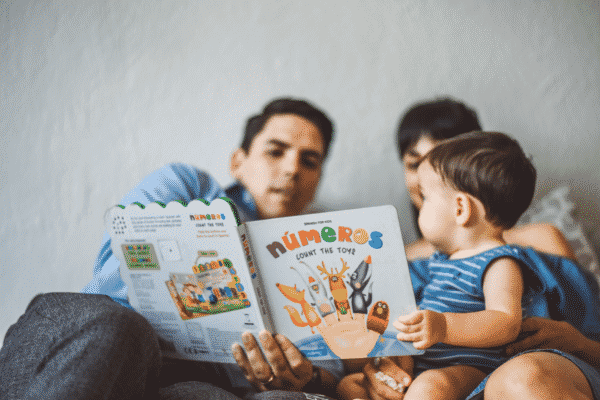The love for reading was instilled in me at a young age. Even now, a book has the power to truly envelop me in its world.
And so it was a no-brainer for me to want to raise a reader when I had my own child, and to instil a love for reading.
Reading helps young children’s development in many ways. It helps to spark imagination, stimulate curiosity, help them learn and build associations about the world, understand our own and other cultures, and develop early literacy skills.
There is ample research also to show that when families and children 0-8 share a routine of reading, it fosters healthy brain development, healthy relationships, a love of reading, and the literacy skills critical for school success.
So how do we as families create a shared love of reading, especially in times of screen-overload? Here are 3 tips that you can start implementing right now.
Start reading with/to your children from when they are born
There is a common misconception amongst parents that they should wait until a child can sit up/talk before they should be reading or read to. Newborns benefit from the experience of hearing stories that are live, in person and directed at the child. Research has shown that the number of words an infant is exposed to has a direct impact on language development and literacy. So as an example, if you would like your child to be proficient in their family language, start reading them books, any books from your family language. As your baby starts to grow and is read to, they take it all in: vocabulary and language structure, numbers and math concepts, colours, shapes, animals, opposites, and all kinds of useful information about how the world works. So from the perspective of a child who is going to be multilingual, this is critical.
When my child was born, one of the stories that was read daily to my child was “goodnight moon” and we would read it in Punjabi/Hindi/Tamil. When my child began to speak, they knew all the words to the book in all the languages and could recite them independently.
READ ALSO: Believing in your child’s academic ability can actually improve grades

Be a role model for your child
When you read books yourself, you are modelling that reading is an enjoyable activity. You could say “This is Mummy’s book. This one is Baby’s book.” Just by looking at books with your child and talking about them, you can be a good model for using language and books.
Your child will learn by watching you hold a book the right way and seeing how you move through the book by gently turning the pages. Also, reading with/to your children creates an emotive connection with your child as well as a positive association with books that will last a lifetime.
The other critical component is to create an engaging experience that makes your child want to read, especially in a world that is full of visual and auditory distractions. So how can we as parents do that?
- Use different tones/voices when reading to your children to bring the book, its world and characters to life, thereby engaging the child emotionally, e.g. using an ogre voice
- Read books that allow for children’s involvement within the books, for example books that have words that rhyme or predictive text
- When children are young, read books that have colourful and aesthetically pleasing illustrations to keep them engaged.
READ ALSO: Play-based experiences to teach your kids about your cultural festival

Immerse your child in a world of books
Ensure that your child is surrounded by books. Expose them to an array of characters, stories, facts and information.
For slightly older kids, a fun practice is to get them to choose their own book once a month or so on the supermarket run.
If you don’t want to buy books, libraries are a great place to surround your child with books. Nowadays, there’s also audio books that allow your children to listen to stories/encyclopaedias etc.
Visit your local council library frequently – they typically hold many book-related events designed for kids of varying ages.
For parents like us who are raising multilingual and children who are diverse, it’s great to have books around that feature the languages that you want them to be exposed to, as well as characters that look like your children. Exposing children to diversity in books will prepare them for life in a diverse world. Personally, I have seen how impactful this has been. Prior to Janmashtami, I bought a storybook that explained the festival of Janmashtami. My child simply loves the book – it has built some great associations and understanding of the festival in their mind.
Implement some of these tips in your children’s lives and watch how they create a love for reading.
READ ALSO: A play-based approach to home language learning
Link up with us!
Indian Link News website: Save our website as a bookmark
Indian Link E-Newsletter: Subscribe to our weekly e-newsletter
Indian Link Newspaper: Click here to read our e-paper
Indian Link app: Download our app from Apple’s App Store or Google Play and subscribe to the alerts
Facebook: facebook.com/IndianLinkAustralia
Twitter: @indian_link
Instagram: @indianlink
LinkedIn: linkedin.com/IndianLinkMediaGroup




